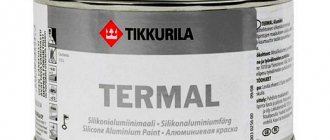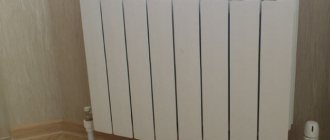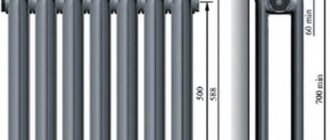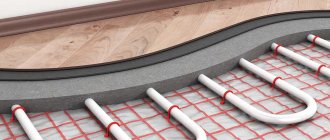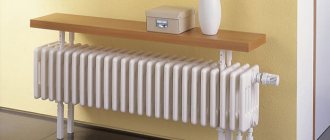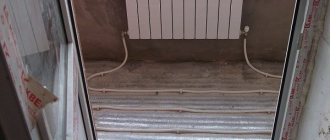How to paint a battery
Specially selected paint for hot radiators will help eliminate intoxication of residents and ensure long service life of the radiator.
Most paints normally tolerate the temperatures to which the radiator heats up.
It is important to understand here that the paint coating must also protect the metal from corrosion and not lose color brightness over time. You should choose from the following options:
- Acrylic water-dispersion paint - dries quickly, does not emit an unpleasant odor when heated, has a bright color that lasts a very long time even when exposed to direct sunlight;
- Alkyd paint - withstands temperatures up to 90°C, adheres well to the surface, but is not durable, and when applied it emits a strong, unpleasant odor.
- Acrylic paint with solvent - the surface does not need to be primed to apply it, and the paint itself is not afraid of high temperatures and moisture. A distinctive feature is the glossy shine of the coating.
- Oil paint is now used quite rarely, giving way to acrylic paint. This coating quickly becomes cracked and can emit an unpleasant odor when heated.
The best way to paint hot batteries
The influence of hot water is considered the basis for the premature failure of heating radiators - over time, pockets of corrosion are found on metal surfaces. To prevent this process, specialized types of paint must be used to paint batteries.
A high-quality paint composition should be able to withstand very high temperatures, have a stable film structure and store the first tone for a very long time. Moreover, if the owner prefers to make repairs in winter, it is best to choose paint without a strong odor.
To paint heating radiators during the heating season, it is best to use the following paint options:
- Alkyd. This material does not have a strong odor, retains the first shade for a long time and is excellent for interior metal work;
- Acrylic. Paints based on this base perfectly resist very high temperatures and are perfect for applying to home heating radiators. Acrylic compositions retain color for a long time, but have a bad odor, so the use of these paints for indoor work is limited. There is a variety of acrylic-based paints that need to be mixed with special extractants; they are distinguished by very high covering qualities and an impeccable glossy film, and to apply this paint no preparatory surface primer is required;
- Oily. They are stable and good paints, but they have an important drawback - a very long setting time.
In addition to these paints, aerosol cans with auto enamel can be used to paint heating appliances. The sprayer greatly facilitates the work and makes it possible to practically use the material.
Is it possible to paint hot radiators during the heating season?
Many people renovate their apartment in winter, and the question often arises: is it possible to paint hot radiators?
Modern paints have a number of positive qualities that allow you to paint your radiator at any time.
Heating appliances in an apartment play the role of not only a source of heat, but they are also part of the interior, which means they should always look good.
In this article you will learn how to paint heating radiators with your own hands.
Radiator paints and necessary tools
Many people believe that only the front part of heating radiators should be painted, but, unfortunately, this conclusion is erroneous.
Often, especially with Soviet batteries, rust spots begin to appear, and if they are not eliminated, the corrosion can spread further.
Good paint will help get rid of unwanted corrosion. To find out what paint to paint radiators with, you need to find out the characteristics of this product.
The purchased paint must be resistant to elevated temperatures, because radiators get very hot in winter, and maintain a natural color for a long time.
To choose the right paint and varnish material, you need to know what types are available for sale.
Acrylic paint has a natural color over a long period and is famous for not having a strong odor.
This option is well suited for painting radiators in winter, because you don’t really need to ventilate the apartment.
Alkyd paint has high temperature resistance and is therefore ideal for radiators. One of the disadvantages is the increased smell, so it is better to use it in the warm season, and not during the heating season.
There is another type of acrylic paint that is used in conjunction with a solvent. This material has good performance, firstly, the paint can be used without additional primer, and secondly, the coating has a good appearance and a glossy surface.
The well-known oil paint used to be a popular product, but with the development of the technological process it faded into the background.
This is the main list of paints and varnishes for cast iron radiators that can be purchased. For panel radiators, you can use aerosol paints (preferably auto enamel).
It is no longer fashionable to have white batteries, so do not be afraid to experiment with colors, the main thing is that the coating fits into the design of the apartment.
In a children's room, you can decorate radiators brightly, especially panel radiators, on which you can reproduce the whole landscape.
So how to paint radiators and in what style is up to you.
But it should be remembered that in order for the coloring material to adhere well, you must have a special tool, such as:
- sandpaper for pre-cleaning;
- a sharp object or knife to remove old paint;
- several types of brushes;
- small roller;
- unnecessary rags for cleaning the room.
This entire set will be needed for high-quality work and will help transform old and ugly radiators into a luxurious piece of furniture.
Preparatory work and process of painting batteries
To understand how to paint a heating radiator, you need to know the principle of the work being performed.
Like all types of construction work, the painting process begins with the preparation of batteries. First of all, it is necessary to eliminate contaminated areas and check the product for corrosion areas.
Once the old paint and dirt have been removed, the heating radiator should be wiped with a damp cleaning cloth.
Swollen areas must be cleaned with sandpaper, and if rotten areas are found, they must be eliminated.
At the final stage, you should coat the radiator with a primer mixture, but you should only take into account the characteristics of the further material, because some types of paint and varnish products do not require a primer layer.
Several types of cleaning are used to clean heating devices from dirt and old paint. The first method is called chemical, and the second method (which involves using a special tool) is called mechanical.
To remove dirt chemically, solutions consisting of acids and solvents are used. You can prepare this mixture yourself or purchase it at the store.
To prepare the solution at home, you will need the following ingredients:
- sodium carbonate (soda ash), about one kilogram;
- slaked lime, in the same proportion;
- water, about five liters;
- large capacity, more than ten liters.
The solution is prepared as follows. Soda is dissolved in hot water, the water temperature is about 60 degrees, after which lime is added in small doses. This is done to prevent strong foam.
The mechanical method involves the use of a special tool or regular sandpaper.
The process is long and dusty, but to speed it up you can use a special drill attachment or use a grinder.
In this case, it is necessary to follow safety rules and carry out such work carefully so as not to damage the radiator.
As for the painting process itself, no special skills are needed, the main thing is to know how to paint a heating device correctly.
Before starting work, you should set up a workplace, cover the floor with paper (or other material), protect the walls with a gasket (you can put a large sheet of cardboard), prepare the necessary tools.
Apply paint to radiators with a brush, preferably from top to bottom - this way there will be no drips. The layer should be thin and uniform. After the paint has dried, you need to apply a second coat.
The internal parts of the radiators must be painted first to avoid getting dirty in the process. Small parts and difficult places should be painted using a sponge or roller.
That's the whole principle of painting radiators.
Useful tips
You can do the job efficiently and beautifully yourself, you just need to take into account all the nuances and follow the rules.
Here are some more useful tips from the professionals:
- the painted radiator should not have drips - to do this, apply the paint in a thin layer and with smooth movements;
- It is better to paint the back of the heating device using a curved brush with a long handle;
- if a chemical method is used to clean radiators, then it is necessary to use personal protective equipment;
- After completing the painting work, the room must be well ventilated. If the work is carried out in winter, then you should use paints without a strong odor;
- pipes and hidden elements do not need to be painted, which will help preserve heat transfer;
- To understand which paint is best to paint, you need to study all the characteristics of the product.
Video:
There is nothing complicated in this type of work, therefore, you can paint the heating system yourself.
You just need to listen to the advice of experts, and your radiator will be as good as new.
If you play with your imagination and change the color of the radiators, they will become even better than new ones.
New shades of the restored battery should be chosen based on the interior of the room: if it is a children's room, then it is better to choose light colors, and the radiator in the bathroom should be made in a neutral color.
What paint to paint the radiators in the kitchen or in other rooms is up to you personally to decide.
Video:
It should be remembered that new bimetallic radiators are very capricious, and to paint their surface you should contact a specialist (preferably at a service station); in case of self-repair, you must use auto enamel in the form of an aerosol.
For panel radiators, both aerosols and regular paint can also be used, but you should take into account that it is necessary to paint the grille, and not just the panel itself.
Restoring radiators is a primitive job, so feel free to update the design of your heating devices and enjoy the results.
Painting hot batteries
After preparing the radiator, you can proceed directly to painting. A few recommendations when painting the battery:
Painting should be done with a brush, not a sprayer. The brush must be thin enough to fit freely into the space between the battery sections;
- Painting of the battery begins from its upper part, preferably from the inside. If you do not want to stain the floor with paint, then you should place newspapers or plastic wrap under the radiator. The wall behind the battery should be covered with tape or at least covered with cardboard. And in order to better paint the back of the radiator, you should take a special brush with a rounded handle;
- It is recommended to apply paint in several layers, but they should not be too thick, otherwise the battery will take a very long time to dry. It is best to apply one coat, wait until it dries, and then apply the next one;
After the battery is painted, you need to leave the room and wait until the paint is completely dry. If there is such an opportunity, then it is worth opening a window or at least a window.
Painting a battery in winter is not such a difficult task. The main thing is to choose a good heat-resistant paint and apply it correctly.
Very often we receive the question “How much does it cost to paint a square meter of our part?” It would seem that everything is simple, but to answer such a question, you need to know a lot of input data.
Let's figure out what really affects the cost of painting a product:
The surface area of the product to be painted; The color in which the product must be painted (the cost of paint according to the RAL classic catalog can vary from 4 to 20 or more Euros per kg
paints); The thickness of the metal from which the product is made (for a metal thickness of 2 mm or more, we introduce a coefficient for additional heating); Number of products to be painted; Dimensions of the product (it is important to understand how much space the product takes up in the polymerization oven).
Let's give examples for clarity:
Example No. 1
Example No. 2
We paint a galvanized iron sheet 2 mm thick and 1000*1000 mm in size on one side. In color according to RAL 5017, smooth gloss. Quantity: 20 pieces. Those. The painting area is 20 square meters. meters. The cost of painting is 2960 rubles including VAT.
Now we paint the frame, welded from a 20*20*1.5 profile pipe, measuring 1000*1000*1000 mm. The result is a rectangular parallelepiped with a surface area of 0.96 sq.m. According to “straightforward” logic, the cost of painting such a product should be 142 rubles including VAT. The price for powder coating of such a product does not even cover the costs, and you need to calculate the price for powder painting of a part using a completely different formula.
Only a manager who understands the subject and has all the data for calculation can calculate this.
Don't waste your time guessing the cost! It’s better to call or write to us right away - a specialist will quickly calculate the exact cost of painting, report the result in a call back or write to you by email.
Painting recommendations
- The quality of painting of cast iron batteries also largely depends on how well they are prepared. A smooth foam roller of small diameter is optimal as a tool for applying paint, and a brush is useful in hard-to-reach places. To decide for yourself how to paint most conveniently, you should think about removing the batteries. The radiator, separated from the pipes, can be coated with the composition on all sides, so there will be significantly fewer hard-to-reach places. However, this method does not always pay off; sometimes it is easier to paint the battery more thoroughly without wasting time on removing it. It all depends on the specific circumstances and the shape of the radiator.
- A very important factor is the temperature of the surface to be painted: the radiator must be cold. To the question “is it possible to paint hot batteries?” any specialist will answer unequivocally: this cannot be done. The most convenient moment is when there is no heating season. But the beginning of the heating period will not be a hindrance if you close the valves on the radiators, stopping the access to boiling water. It is enough to wait until they cool completely to start painting. If paint is applied to a hot radiator, it will lie unevenly, swell, and various stains and stains will probably form. Moreover, you can turn on the heating only when the paint is completely dry.
ATTENTION: Never paint hot batteries!
Painting radiators and heating pipes requires care and precision. It is good to use brushes, small rollers, and spray cans. It is optimal to use a spray gun to process the previously removed battery, then all hard-to-reach areas will be perfectly painted. It is from those places that are least accessible that you should start painting
It is important to maintain a uniform layer thickness, otherwise the color may further differ in different areas. It is recommended to start painting from the top, then accidental drips will not spoil the lower part. You need to cover the entire battery with the composition, not limited to its front part.
It is more effective to apply paint in two thin layers, and wait until the first one has completely dried before painting again. Then there will be no drips, and it’s easier to achieve perfect evenness with thin layers.
Painting instructions
Coloring rules:
- First you need to check that the floor and walls are protected from dye.
- If necessary, add additional cellophane.
- First you need to study the instructions for the coloring composition, stir the mixture to obtain a homogeneous consistency.
- Begin painting from hard-to-reach areas. To do this, use narrow brushes with a curved handle.
- The outer part of the battery is painted with a roller or wide brush.
- You need to paint from top to bottom, this way there will be no smudges and the composition will not splash to the sides.
- To get a high-quality coating, you need to apply 2 layers of paint.
- The second layer should be applied only after the previous one has completely dried.
6 tips for painting hot radiators.
If painting is carried out using an aerosol can, then spraying the paint should be done from a distance of 30 cm . After painting the battery, you need to ventilate the room. If these requirements are met, the radiator can be painted while the heating is on.
Rules to consider when painting hot batteries:
- When painting, no paint streaks should form on the surface of the heating device. To do this, apply the product in a thin layer.
- The back side of the radiator can be painted using a curved brush, or if you don’t have one, you can use a toothbrush.
- If you decide to clean a warm radiator in a room using a chemical method, you need to wear protective gloves and clothing to prevent chemicals from getting on your skin. A respirator can be used to protect your respiratory system.
- After the radiator is painted, it is necessary to ventilate the room. The best option would be to use odorless acrylic paints or special dyes produced for painting heating radiators.
- Hidden parts and heating pipes do not need to be painted, as this will ensure better heat transfer.
- Before purchasing a paint composition, you should carefully read the instructions for applying the dye.
Pay attention to: Painting cast iron radiators: surface preparation, choice of paint and varnish material, step-by-step painting instructions
Central heating radiators can be hot painted in winter during the heating season. Modern compounds can withstand high temperatures and do not lose their strength characteristics. If you follow all the recommendations when preparing heating appliances and performing work on painting hot radiators, the coating will be durable.
Read further:
Painting cast iron radiators: surface preparation, choice of paint and varnish material, step-by-step painting instructions
Paints for heating radiators: types and varieties of compositions, popular brands of paints
High-quality painting of heating radiators with powder paint with hot polymerization
Painting heating pipes: how and what to paint with, step-by-step instructions.
Radiator paint
Tools and materials for painting radiators
The tools and compounds used in preparing the radiator are of great importance. A special brush mounted on the drill will ensure optimal treatment of the battery. Wash solutions also work effectively: it is good to apply them to the entire dry surface of the radiator with a paint brush, and then wrap it with film. The paint will soften and be easily removed within an hour; you don’t even need to use a drill - a regular spatula is enough. The advantage of special removers is that they are harmless to metal; they only destroy layers of paint.
After there are no traces of the old paint left, the surface must be sanded and degreased. Any weakly alkaline solution, white spirit, is suitable for this. At the final stage of preparation, a layer of anti-corrosion primer is applied to the radiator. After completing all these steps, you can be sure: the surface is ready, the paint will adhere perfectly to it, and will last reliably and for a long time.
Choosing the Ideal Battery Paint
It is important to determine which paint is best to transform radiators. There are a number of requirements that the paint applied to batteries must meet
Heat resistance of the paint is required at least one hundred degrees; abrasion resistance and non-toxicity are also required, since the batteries are regularly cleaned and the radiator itself heats up. The greatest heat resistance is achieved by paint containing metal powder instead of coloring pigments.
There are special paints for radiators on sale; many people use water-based enamels and heat-resistant varnishes. The paint you choose must be suitable for coating metal and match the primer. Good compounds are durable, do not change color, and can protect themselves from corrosion.
Glossy shine and long-term color fastness are ensured with acrylic enamels based on organic solvents. But they smell quite strong when applied.
Water-dispersed paints dry quickly, but it is important to select them carefully, choosing special types. After painting with alkyd enamels, the uniformity of the coating is guaranteed, it will be durable and resistant to influences
However, the smell can be observed not only during the painting process, but also some time after drying, released from heating.
Color selection
The decision on what color is best to paint the radiators is up to the owners. A wide range of products and various formulations are now available. White enamels and silver are considered classic. Some choose colors in accordance with the interior, lighting, general style of the apartment and design features. Gold and bronze shades, subtle patterns and designs look unusual.
If the look of your old radiators no longer pleases you, then you can try to breathe new life into them through experiments
Work order and paint selection
In essence, the entire process of changing the appearance of radiators by painting can be divided into the following stages:
choosing a coloring composition; preparatory work; painting; drying.
Among the many existing paints and enamels, the following heat-resistant compositions are suitable for application to heating devices:
acrylic based; alkyd based; based on heat-resistant varnish with the addition of aluminum, bronze or other powder; based on silicone resin.
Answering the question whether it is possible to paint with water-based paint, we note that it is not only possible, but has also become very popular. Water-based compositions with acrylic polymer are modern, odorless paints that have the properties of not fading for a long time. They can be given any color by adding the appropriate pigment to the base enamel. When choosing, you need to pay attention to the thermal resistance of the coating. Acrylic paint for radiators is designed for an operating temperature of 80 ºС.
Alkyd compositions are produced on the basis of organic solvents, the strength of their coating is higher than that of acrylic ones. But practice shows that you should not choose alkyd enamel if you plan to paint it white or light colors. The fact is that such coatings quickly turn yellow, reducing all your efforts to zero. You can paint batteries with alkyd compounds, but it is advisable to choose dark colors.
A little about what paint cast iron radiators are coated with to give them an aesthetic appearance. Most often, two-component compositions are used for this purpose, where heat-resistant varnish is mixed with powder of a certain color (silver, bronze, gold). They are inexpensive, apply well to the surface and are durable. The same can be said about silicone coatings, only the enamels for their application are very expensive.
We recommend: How to sew roller blinds with your own hands - step-by-step instructions
To update the appearance of radiators, you can also use compounds sold in aerosol cans. They have a very wide range of colors and significantly speed up the painting process.
3
The second update method is to remove the batteries
There is another way to change the appearance of batteries. It is more labor-intensive, because you have to completely remove the radiators. However, the result will be much better at keeping your batteries free of rust and dirt. First you need to reset the heating risers. After this, you will need to completely unscrew all the plugs and blind plugs, as well as remove the jumpers. Next, you need to anneal the battery (heat and hold it at high temperature) using a powerful household hair dryer. Then we disassemble the radiator into sections, using a special key for this. Don't forget to tap the radiators with a mallet to remove any rust. After this, the sections are cleaned with a wire brush.
Removing the battery is a more labor-intensive way to change its appearance, but the result will be better
In the next step, reassemble the battery using ordinary rubber gaskets. In this case, the size of the outer part should be slightly smaller than the end of each section. After this, install and connect the radiator to the heating network. Apply primer to the surface of the clean battery and begin painting. The operating algorithm is almost the same. The only difference is that the batteries will not be as hot as in the first case. This will make them take a little longer to dry. Often, residents of houses paint radiators immediately after dismantling them. In this case, it is possible to paint the surface both in front and behind the battery. In addition, there will be no risk of staining the wall behind the radiator.
Painting technique
Before painting heating radiators during the heating season, you need to familiarize yourself with the rules for carrying out the work and purchase the necessary tools and materials.
The quality of painting depends on the technology of surface preparation for painting work and on the correct choice of paint. The process of painting a hot battery is accessible to any beginner, but some of the secrets of the skill below can help you do this job faster and with better quality.
Tools and materials
Before you paint hot heating radiators in an apartment, you need to buy materials and tools.
Materials you will need:
- paint (alkyd or acrylic, specialized water-based paint is also suitable, but it is better to avoid oil-based paint, as it takes a long time to dry);
- solvent for old paint;
- primer for metal;
- polyethylene film to protect floors and walls.
You need to prepare the following tools:
- scraper for removing coatings that are already outdated;
- medium-grain sandpaper;
- flute brush 50 and 20 mm wide;
- brush with a curved handle 20 mm wide.
Preparation work
First of all, the correct preparation of the base determines whether it will be possible to paint the batteries in winter with good quality.
When preparing the surface of a heating device for painting, you should adhere to the following sequence of actions:
The battery must be freed from dirt and dust. Next, the heating device is inspected with great attention in order to detect corrosion spots on the surface. At another preparation step, it is necessary to remove the old varnish, for which sandpaper and a scraper are used. The cleaned surface of the heating device is finished with a primer solution. Applying a primer to the painted surface allows you to level the base and remove very small pores, which will ensure better adhesion of paint and metal
The primer is selected based on the type of paint. The workplace is covered with polyethylene-based film. It is necessary to secure not only the floor, but also the walls around the heating device.
The main difficulty in preparation is removing the coating, which is already outdated. There are several options for saving outdated paint, but the chemical method is considered very affordable. To prepare the washing composition you will need to purchase: soda ash - 1 kg and slaked lime - 1 kg, you will also need 5 liters of water.
Stage of preparing the washing solution:
- pour hot water into a large container (at least 10 liters) and dilute soda ash in it;
- then add slaked lime in small doses;
- The mixture is thoroughly mixed, after which it must be allowed to stand for 10-15 minutes.
The mixture, which is already ready for use, is applied to the surface of the heating device, allowed to stand for 5-10 minutes and then begin to remove the paint with a scraper.
When using a mechanical method for cleaning paint from a battery, it is best to use a drill with a special attachment. When performing work, you should not press the tool too hard so as not to damage the integrity of the metal.
After completing all the steps of surface preparation for painting, we proceed to the key work.
Painting instructions
When painting a battery, it is recommended to adhere to the following rules:
- Check that the walls and floor are reliably protected from paint penetration. If necessary, lay additional film sheets;
- At the beginning of work, you should read the instructions for the paint composition and, if there is a need to mix the contents of the can, to obtain a homogeneous mass;
- They begin to paint the heating device from very inconvenient and hard-to-reach places. For these works, narrow flute brushes and brushes with a curved handle are used;
- The external parts of the heating device are painted with wider brushes or a small roller;
- It is recommended to paint from top to bottom. Likewise, drips are easier to avoid;
- To obtain a good coating, apply 2 layers of paint. The second layer is applied after the first layer has completely set.
If you choose a can of aerosol paint for work, spray it from a distance of at least 300 mm.
As soon as the work is completed, it is recommended to ventilate the room.
The tips listed above resolve the question of whether it is possible to paint radiators when the heating is on - if all requirements are met, heating radiators can be painted even at high temperatures in the heating pipe system.
Preparatory work
It is necessary to prepare the surface for painting in advance. The quality of the coating depends on this.
When preparing a radiator for painting, perform the following work:
- First you need to clean the heater from dirt.
- The battery is then inspected to look for rust.
- Then, using a scraper and sandpaper, remove the old paint.
- After the surface of the battery is cleared of the old coating, the battery is treated with a primer solution.
- Then a primer is applied, this will level the coating, remove unevenness, and ensure adhesion of the paint to the surface.
- The primer is chosen depending on the type of paint.
- The work area is covered with cellophane, and both the floor and the wall should be covered.
The main difficulty of the preparatory stage is removing the old paint. There are several methods for removing old coating. The most accessible is the chemical method.
To prepare a chemical composition for paint removal you need to prepare:
- 1 kg of calcined salt;
- 1 kg lime;
- 5 liters of water.
The washing solution is applied to the heating device, left for 5-10 minutes, and then the paint is removed using a scraper.
The washing solution is prepared as follows: pour hot water into a 10-liter container, add soda, stir it, add lime in small portions, mix the solution and leave for 10-15 minutes. This solution is applied to the heating device, left for 5-10 minutes, and then the paint is removed with a scraper.
Pay attention to: Painting gas and electric stoves at home
The mechanical method of removing paint from a radiator is based on the use of a drill with an attachment. During work, do not press hard so as not to damage the metal. When the preparatory work is completed, painting begins.

